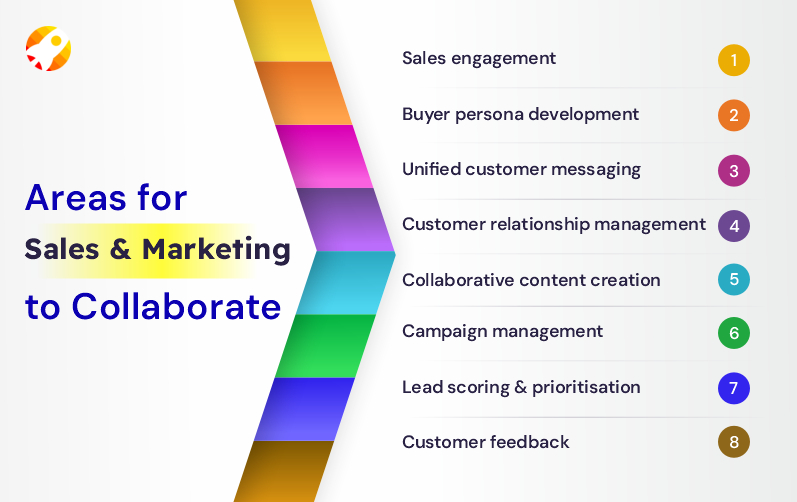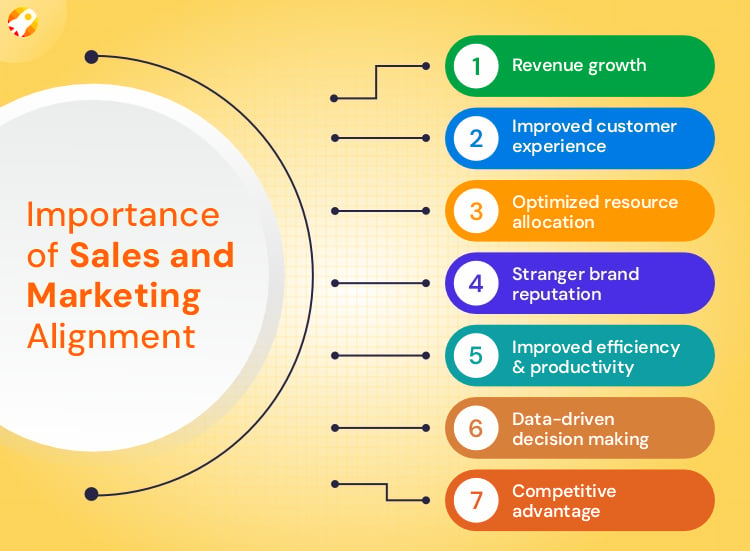How to Achieve Marketing & Sales Alignment?
Think of a scenario, where you are a sales guy and marketing keeps sending you leads that are a complete mismatch for your product. Frustrating, right? Or maybe you’re in marketing and sales and keep complaining that your leads are junk.
The truth is, that marketing and sales need to work together like peanut butter and jelly, not oil and water. But why exactly is that and how can you make it happen?
This blog post will explore the reasons why marketing and sales alignment is crucial for your business success, and provide actionable tips to break down departmental silos and create a revenue-generating team.
Why can’t marketing and sales get along?

Marketing and sales, while crucial partners in driving revenue, can sometimes find themselves at odds. When marketing and sales departments work in silos, they create several challenges for themselves and the organization as a whole.
Here are a few reasons.
👉 Difference in goals and metrics
Marketing often focuses on long-term brand awareness and lead generation, measured by website traffic, brand sentiment, or qualified leads (MQLs). Sales, on the other hand, prioritizes short-term goals like closing deals and has metrics like conversion rates and revenue generated.
👉 Communication breakdowns
Marketing might create campaigns that sales feel are out of touch with customer needs or generate leads that aren’t qualified for sales efforts. Without clear communication on target audiences, messaging, and lead quality, frustration can build.
👉 Conflicting priorities
Marketing might experiment with new strategies that take time to show results, while sales crave a constant flow of qualified leads. This tension can lead to a lack of support for long-term marketing initiatives.
👉 Compensation structures
Sales teams are often compensated on commission, while marketing has a fixed salary that appears on their pay stub. This can create a feeling of competition rather than collaboration.
👉 Inefficient lead nurturing
Without collaboration, leads may not be properly nurtured. Marketing might generate leads, but without sales following up promptly, those leads can go cold. This wastes both marketing’s efforts and potential sales opportunities.
Recommended Read: 7 Shared Mailbox Best Practices For Better Team Collaboration
Issues arise when marketing and sales are not aligned.
A misaligned marketing and sales team can lead to a number of issues that can significantly hinder a company’s success.
Some of the biggest problems that arise when these two crucial departments aren’t working together effectively:
👉 Wasted Resources
Marketing efforts might be attracting the wrong audience and generating leads that sales can’t convert. This wastes the marketing budget and sales time spent following up on unqualified leads. Optimizing the digital marketing budget allocation can help in reaching the right audience and generating qualified leads.
👉 Frustration and finger-pointing
When goals aren’t aligned, both teams can become frustrated. Marketing might blame sales for not converting leads, while sales might blame marketing for generating unqualified leads. This negativity can hurt morale and productivity.
👉 Poor customer experience
Inconsistent messaging between marketing and sales creates a confusing experience for potential customers. They might encounter messaging that doesn’t match the reality of the sales process, leading to disappointment and lost opportunities.
👉 Missed sales opportunities
Sales might be missing out on qualified leads that marketing isn’t effectively nurturing. Without clear communication and collaboration, leads can go cold before sales even have a chance to connect.
👉 Lower revenue
Ultimately, the biggest consequence of marketing and sales misalignment is lower revenue. Without a smooth handover between qualified leads and sales outreach, companies struggle to convert leads into paying customers.
How can marketing and sales work together?

Sales and marketing teams are two sides of the same coin, both working towards the ultimate goal of driving revenue and customer growth. However, traditional departmental silos can hinder their effectiveness.
To achieve true success, these teams need to work in collaboration. Some of the areas include:
➡️ Sales Engagement: Marketing equips sales teams with the necessary tools and resources to close deals effectively.
➡️ Buyer Persona Development: Create a detailed profile of the ideal customer to ensure both teams target the right audience.
➡️ Unified Customer Messaging: Avoid confusing customers with mixed messages. Marketing’s industry knowledge should be combined with the real-world experience of the sales team to craft consistent, impactful messaging that resonates with customers.
➡️ Customer Relationship Management (CRM): Both departments collaborate on using a CRM system to track leads, customer interactions, and sales pipeline.
➡️ Collaborative Content Creation: Don’t let marketing materials gather dust. Sales can provide insights on what resonates with customers to inform content marketing strategies. Marketing can use their creative expertise to craft compelling content like case studies and product datasheets, incorporating real-world anecdotes and feedback from sales to make them more impactful.
➡️ Campaign Measurement: Marketing shares campaign data and insights with sales, allowing them to tailor their approach based on what resonates with leads.
➡️ Joint Lead Scoring and Prioritization: Not all leads are created equal. By collaborating on lead scoring criteria, marketing and sales can identify and prioritize high-quality leads. Sales can focus their energy on those most likely to convert, while marketing attracts the right kind of leads in the first place.
➡️ Customer Feedback Loop: Sales gathers customer feedback and shares it with marketing to inform future campaigns and messaging.
Strategies for marketing and sales to work together
Marketing and sales are the cornerstones of any revenue-generating organization. When these two teams operate in silos, it can lead to wasted resources, frustrated customers, and missed sales opportunities. However, when they work collaboratively, it can create a powerful synergy that drives growth.
✅ Define customer persona
Action: Develop a detailed ideal customer profile together. This persona should include demographics, firmographics, buying behaviors, pain points, and goals.
Benefits: A shared understanding of the target customer ensures both teams tailor their efforts to attract and convert the right audience. Marketing creates content and campaigns that resonate with their needs, while sales reps are equipped to address their specific challenges.
✅ Collaborative creation of content
Action: Move beyond simply handing off marketing materials to sales. Involve sales reps in the content creation process. Solicit their input on topics, pain points, and customer terminology that resonate most.
Benefits: Sales reps have the front-line experience of what resonates with potential customers. Their insights can be used to create content that is both informative and persuasive. Marketing can then leverage its creative expertise to craft compelling content like case studies, white papers, or blog posts that effectively address customer needs.
✅ Joint lead scoring and prioritization
Action: Work together to establish a lead scoring system that identifies and prioritizes high-value leads. This system should consider factors like website behavior, demographics, engagement level with marketing campaigns, and buying intent signals.
Benefits: A collaborative lead scoring system ensures that marketing attracts qualified leads who are more likely to convert. Sales reps can then focus their energy on nurturing these high-potential leads, improving conversion rates and reducing wasted resources.
✅ Sharing of sales tools and resources
Action: Marketing doesn’t just create content; it equips sales with the tools they need to close deals effectively. This can include sales presentations, product brochures in the foam of bifold or trifold brochures, battle cards, and competitor analysis reports.
Benefits: Sales reps have everything they need to confidently present the product or service to potential customers. This helps the sales process and improves win rates.
✅ Customer Relationship Management (CRM) alignment
Action: Both marketing and sales should take advantage of a CRM system. This ensures everyone has access to the same customer data, including lead interactions, communication history, and purchase behavior.
Benefits: A centralized CRM helps transparency and avoids confusion. Marketing can customize campaigns based on past interactions, and sales reps have a complete view of the customer journey, allowing them to personalize their approach.
✅ Open communication and feedback loops
Action: Regular communication is key. Schedule regular meetings for marketing and sales teams to discuss campaign performance, customer feedback, and areas for improvement.
Benefits: Open communication helps trust and understanding between the teams. Sharing campaign data allows sales to customize their approach based on what resonates with leads. Sales feedback on leads and content helps marketing refine their strategies for better alignment.
✅ Shared goals and metrics
Action: Move beyond departmental goals and establish shared objectives focused on driving revenue and customer acquisition. Track metrics relevant to both teams, such as website traffic, lead generation, conversion rates, and customer lifetime value.
Benefits: When both teams work towards shared goals, they are more likely to collaborate effectively. Tracking shared metrics increases accountability and allows them to measure the overall success of their combined efforts.
✅ Incentive programs that encourage collaboration
Action: Consider implementing sales incentive programs that reward both marketing and sales teams for achieving shared goals. This could involve bonuses based on exceeding revenue targets or customer acquisition goals.
Benefits: Shared incentives encourage teamwork and break down departmental silos. When both teams are rewarded for the same outcome, they are more likely to collaborate and support each other’s efforts.
✅ Sales & marketing alignment workshops
Action: Organize joint workshops where both teams can discuss challenges, brainstorm solutions, and create a shared vision for lead generation and customer acquisition.
Benefits: Workshops provide a dedicated space for open communication and problem-solving. By working together, marketing and sales can identify areas for improvement and develop strategies to overcome obstacles.
✅ Customer journey mapping
Action: Collaborate on creating a customer journey map that outlines the different touchpoints a customer has with your brand, from awareness to purchase and beyond.
Benefits: A customer journey map helps both teams understand the customer experience at each stage. This allows them to customize their efforts to ensure a smooth and consistent journey, improving customer satisfaction and retention.
✅ Sales participation in marketing campaigns
Action: Encourage sales reps to participate in marketing campaigns by offering early access to marketing materials, providing testimonials for content creation, or even participating in webinars or social media campaigns.
Benefits: Sales involvement adds credibility and authenticity to marketing efforts. Their real-world experience can enhance marketing materials and provide valuable insights for audience engagement.
✅ Co-selling programs
Action: Develop co-selling programs where marketing and sales work together to target specific accounts or industries. This could involve joint presentations, collaborative proposals, or strategic account planning.
Benefits: Co-selling helps to increase the strengths of both teams. Marketing can identify and qualify leads, while sales reps bring their closing expertise to the table, maximizing win rates for high-value accounts.
✅ Recognition programs
Action: Implement gamification elements or recognition programs that celebrate successful collaboration between marketing and sales. This could involve awarding points for shared leads, recognizing top performers in joint initiatives, or creating leaderboards to track team progress.
Benefits: A little friendly competition can help collaboration and motivate teams to achieve shared goals. Recognizing successful partnerships reinforces positive behaviors and encourages continued collaboration.
✅ Invest in technology for collaboration
Action: Explore marketing automation and CRM platforms that facilitate seamless data sharing and communication between teams. These tools can automate lead nurturing workflows, track campaign performance, and provide real-time insights to both marketing and sales.
Benefits: Sales software like SmartReach.io, provides a collaboration platform, by giving both teams a centralized platform for data, communication, and campaign management. This improves efficiency, reduces errors, and ensures everyone is working with the most up-to-date information.
Why do marketing and sales alignment matter?
There are many reasons why marketing and sales should work together. Some of them are mentioned below.

Revenue growth
When marketing and sales are on the same page, they can attract the right audience, nurture qualified leads, and convert them into paying customers more efficiently. This translates to a smoother sales funnel, higher conversion rates, and ultimately, increased revenue.
Improved customer experience
Consistent messaging and a seamless handover between marketing and sales create a positive customer experience. Customers aren’t confused by conflicting messages, and they receive the right support throughout their buying journey, leading to higher satisfaction and loyalty.
Optimized resource allocation
Siloed departments can waste resources on unqualified leads or misaligned marketing efforts. Collaboration allows them to focus their efforts on attracting and nurturing high-potential leads, maximizing the return on investment for both marketing and sales activities.
Stronger brand reputation
A unified marketing and sales approach strengthens your brand message and builds trust with customers. When both teams present a consistent brand image, customers are more likely to perceive your company as professional and reliable.
Improved efficiency and productivity
Collaboration helps better communication and knowledge sharing. Marketing teams gain valuable insights from sales interactions, allowing them to refine their targeting and messaging. Sales reps are equipped with the right tools and resources to close deals effectively. This overall improves efficiency and productivity across both departments.
Data-Driven decision making
When marketing and sales share data and collaborate on lead scoring, they can make data-driven decisions about campaign strategies, resource allocation, and sales processes. This data-centric approach leads to more targeted efforts and a higher chance of success.
Competitive advantage
A strong marketing and sales partnership can give your business a significant edge. By working together, you can create a more efficient sales funnel, deliver a superior customer experience, and build stronger brand loyalty, all of which can help you outperform your competitors.
Recommended Read: SmartReach Shared Inbox | Comprehensive Guide
Takeaway: How do marketing and sales work together?
Achieving marketing and sales alignment is essential for any organization aiming to thrive. When these two crucial departments work in silos, it leads to wasted resources, frustrated customers, and missed sales opportunities.
For true marketing and sales alignment to flourish, it requires active support from leadership. Leaders set the tone for collaboration and should be actively involved in developing a culture of teamwork between the departments.
This might involve allocating a budget for joint initiatives, creating cross-functional teams, or rewarding collaborative behaviors.
By demonstrating the importance of marketing and sales alignment from the top down, leaders can empower their teams to break down silos and achieve remarkable results.
However, by implementing the strategies outlined above, marketing and sales teams can help drive revenue growth, customer satisfaction, and overall business success.
Frequently Asked Questions (FAQs)
Why don’t marketing and sales always get along?
Marketing and sales often have different goals (short-term vs long-term) and metrics (brand awareness vs revenue). This can lead to miscommunication, frustration, and wasted resources.
What are the problems caused by misaligned marketing and sales?
Misalignment can lead to wasted resources, frustrated customers, missed sales opportunities, and lower revenue.
How can marketing and sales work together more effectively?
There are many strategies to improve alignment, such as sharing goals and metrics, collaborating on content creation, and using a CRM system together.
What are the benefits of marketing and sales alignment?
Alignment can lead to increased revenue, improved customer experience, better resource allocation, a stronger brand reputation, and improved efficiency.
How can leadership support marketing and sales alignment?
Leaders can set the tone for collaboration by allocating budget for joint initiatives, creating cross-functional teams, and rewarding collaborative behaviors.




